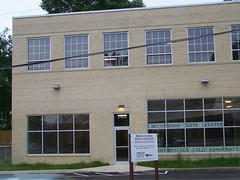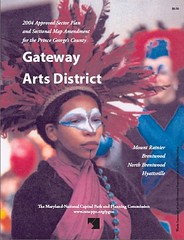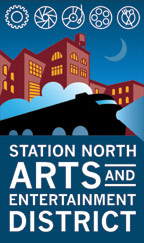More on arts "districts"
I wrote and presented about this topic in July. See "Art, culture districts, and revitalization."
1. But the Post just wrote about this in the context of the Gateway Arts District in Prince George's County, in The State of the Arts District? So-So.. Probably the journalist didn't read the Gateway Arts District Sector Plan.
I happened to have a conversation last weekend (before the article came out) with an artist with a studio in the Gateway District, and I asked about why the Brentwood Arts Center still isn't open. It's supposed to be an education and gallery space, with working studios on the second floor for artists.

She's on the advisory board and mentioned that there have been a lot of permitting problems, which have kept the facility from opening for more than one year, even though the planning agency's parks division will be one of the tenants and provided funding for the building.
But she stated that one of the problems is with how people see the center functioning. A lot of the community members involved in the organization or the advisory committee are not artists, and they want the building to function more as a community center with youth-oriented arts activities--not as a place for artists.
That doesn't surprise me. And I said, they (and she) need(s) to read the Gateway Arts District Sector Plan. It covers community development sure, but it's also about economic development, building a revitalization strategy through a recognition of artists as producers and arts development opportunities.

Interestingly, the Gateway Community Development Corporation and the Anacostia Trails Heritage Areas are very interesting organizations. They are definitely community oriented arts and heritage organizations. They are supposed to be economic development organizations. The membership of the boards of the organization is structured very specifically to be led by the community.
The Gateway board is elected in tranches representing members living in Mount Rainier, North Brentwood, and Brentwood. Hyattsville, for some reason, isn't included. The ATHA board is a bit more problematic, comprised solely of elected officials representing the various jurisdictions that are in the geography of the heritage area, which is designated by the State of Maryland, and is supposed to generate economic value. (See the State report Investing in Our Heritage - Ecomonic Impact Study.)
But after awhile, imo anyway, the board members and their agendas get disconnected from the original intent of the initiatives (either the Arts District or the Heritage Area) and the projects as originally conceptualized, expressed and outlined in their respective management plans. Community members of the board become more focused on "community building" rather than economic development.
Also see these past entries, "Musings on community building and revitalization," and "Civic Tourism."
2. Interestingly, the Los Angeles Times has a story, "L.A.'s Museum of Neon Art is glowing, glowing, gone," which discusses some of the trials and tribulations of the "arts scene" as a economic development strategy in Downtown Los Angeles.
It has some of the same issues as the 14th Street DC "Arts District." (See "Panel Offers Recommendations to DC Government to Secure Mid City Arts District" from DC North.)
In terms of the Gateway District, you can't just wave a wand and create an arts district. Success in an arts district is a function of a number of factors, primarily a large inventory of low cost space, and large buildings, which is attractive to both artists for working space as well as for presenting space for performance spaces (music, theater, film, dance) as well as gallery spaces.
14th Street NW is a little different. At one time the inventory of "undesirable" and somewhat large spaces existed, starting with the ever expanding Studio Theater. But the real estate market caught up with the value of the location--you can't beat the "mid city" area for proximity and centrality--and it ceased being an area with undervalued real estate. With that change, an arts district focus can't succeed without significant subsidies. Downtown Los Angeles has similar issues.
Another trick is to balance the creation of a wide type of arts facilities, including performance spaces, studios, galleries, etc. The problem with Gateway is that for the most part it has spaces for "doing" like the Joe's Movement Emporium, but not spaces for "consuming"/buying (movie theaters, concert halls, etc.).
And the use of extant buildings. For the most part, Gateway has to build new/massively rehabilitate old buildings, and there aren't many appropriate extant buildings to begin with. So right from the start, the real estate value equation doesn't make sense.
Plus the lack of an adequate spatial pattern of blocks, streets, etc. The Route 1 corridor is not a walking environment. Not to mention the lack of density of a nearby population, and demographics that don't particularly favor the consumption of arts performances and products.
An interesting counter example is the Penn Avenue Arts District in Pittsburgh, which has similar issues in terms of household demographics. But they do have buildings, and they have been successful at attracting arts anchors such as a dance company and the Pittsburgh Glass Works, which are both very active places for performances, classes, etc.
Unlike the Washington Glass School which is next to the railroad tracks off Otis Street in Mount Rainier in the Gateway Arts District, the Pittsburgh Glassworks is prominently located on Penn Avenue.
Of course, the increasingly vibrant Station North District in Baltimore shows another example. But they are "blessed" by a still weak real estate market and a huge inventory of available buildings, many quite large (which Gateway doesn't have), which artists and arts organizations can acquire or rent for relatively low cost. Charles Street north of Penn Station has fewer and fewer vacancies now, and the area on North Avenue between Charles Street and Howard Street is slowly but surely being revitalized with significant arts-related uses.

But in any case, this is a long process.
It will take even longer in the Gateway District because some of the basic building blocks that support arts-based revitalization are not present, and the community leadership isn't necessarily sophisticated enough to stay focused and not let mission creep get in the way of their success.
I predict the next article you will see about failures or lack of success is in about 18 months, over "over storing" of restaurants and taverns in the H Street NE neighborhood...
Labels: arts-based revitalization, commercial district revitalization, economic development, nightlife economy



0 Comments:
Post a Comment
<< Home